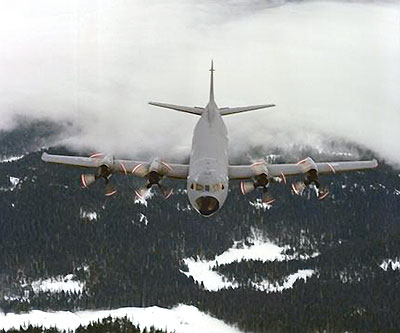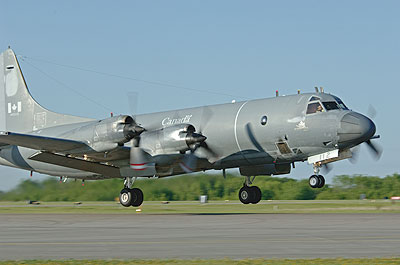 This information has been archived for reference or research purposes.
This information has been archived for reference or research purposes.
Archived Content
Information identified as archived on the Web is for reference, research or recordkeeping purposes. It has not been altered or updated after the date of archiving. Web pages that are archived on the Web are not subject to the Government of Canada Web Standards. As per the Communications Policy of the Government of Canada, you can request alternate formats on the "Contact Us" page.
Commentary
Aurora Renaissance
For more information on accessing this file, please visit our help page.
After months of review and more than a little anguished speculation, the Harper government announced in mid-December 2007 that it would pursue the acquisition of a new surveillance aircraft while upgrading and life-extending “the majority – a paper-thin majority – of the existing Lockheed CP-140 Auroras. Intended, at least in part, to capitalize on previous and substantial investments in Aurora modernization, the revised plan would keep 10 Auroras “safe and operationally viable until 2020.” To this end, the Department of National Defence had “rescinded” a previous work suspension and would now move forward with the next phase of Aurora modernization (i.e., radar, computer and other systems) and with “core structural upgrades.” Ottawa also noted “technology upgrades already made in the [Aurora] fleet may be transferred and reinvested in the replacement aircraft.”
The decision to modernize and life-extend a reduced number of Auroras is by no means perfect – compromises rarely are – but it will permit the retention of critical maritime surveillance (i.e., marine domain awareness) and other capabilities until such time as a credible successor can be secured. That said, the political, military, industrial, financial, and other machinations surrounding the December decision – not least of which was an alternate plan favoured in some DND and other circles to free funding for an expedited Aurora replacement program by aborting Block III of the Aurora Incremental Modernization Project (effectively the heart of AIMP) and the Aurora Service Life Extension Project (ASLEP), reducing Aurora fleet size, and taking vigorous measures to conserve Aurora flying hours – have once again underscored the difficulties in securing consensus and consistency in the realm of fixed-wing maritime aviation.
The machinations also underscored the urgent requirement, as a growing battery of analysts have noted, for a comprehensive and technologically and bureaucratically holistic national strategy for marine domain awareness. Such a strategy must take into account the vast physical size and multifaceted importance of the Canadian Arctic and the maritime approaches to Canada, identify the necessary levels of surveillance coverage, and acknowledge the inherent flexibility of fixed-wing maritime patrol/ISR (intelligence, surveillance and reconnaissance) aircraft for military, quasi-military, and non-military roles. Separate from domestic marine domain awareness requirements, but no less important, must be a parallel recognition of potential overseas requirements for a credible Canadian maritime and overland ISR capability, and the potential for synergies between domestic and overseas capabilities and skill sets.
Unfortunately, as this column has lamented on more than one occasion, Canadian decision-making in the maritime patrol/ISR, coastal patrol, and Arctic surveillance realms has for decades been “...characterized by a monotonous proclivity for indecisiveness, ill-considered qualitative and/or quantitative reductions, false starts, false economies and ill-conceived business plans.” The newly-minted Trudeau government, for example, spared the CP-107 Argus maritime patrol fleet in its 1969 defence policy statement, but promptly short-circuited its variant of a “Canada First” defence strategy by announcing the disposal of the still-youthful (and still useful) CP-121 Tracker coastal patrol aircraft. The nonsensical decision on the Tracker was, quite properly, reversed by the 1971 White Paper, but Ottawa was plunged almost immediately into a complex and convoluted debate over the selection of a new long-range patrol aircraft (LRPA) to replace the Argus. Much of that debate – that may, in fact, foreshadow the forthcoming debate over the Aurora replacement – centred on the degree to which the Argus replacement should be capable of anti-submarine warfare (ASW). Indeed, for a time, it appeared that the new LRPA would possess every maritime patrol, Arctic surveillance, and remote sensing capability except anti-submarine warfare. Adding to the controversy – and perhaps again foreshadowing the future – was an unsolicited proposal from Canadian industry that urged rejection of the proffered contenders from Lockheed, Boeing, Douglas, and Hawker-Siddeley. Under the industry plan, dubbed Project Phoenix, Canada would upgrade 16 of the surviving Argus aircraft for anti-submarine warfare and acquire eight de Havilland Dash 7s and four Boeing 707s for coastal and Arctic surveillance.
The Trudeau government ultimately opted for the Lockheed CP-140 Aurora, a hybrid combining the airframe and engines of the P-3C Orion with a mission avionics suite derived from the S-3A Viking, and, without doubt, the world’s finest long-range patrol aircraft upon service entry in 1980. Entreaties from Canada’s NATO allies, a changing geo-strategic environment and a new Canadian defence policy ironically gave the Aurora a superb ASW capability, but fiscal considerations limited the fleet to a mere 18 aircraft – thereby leading to very high utilization rates, and sowing the seeds for some of the Aurora’s current structural problems. Fiscal considerations and classic bureaucratic wrangling – the report of the interdepartmental committee on the non-military applications of the LRPA remains fascinating reading – also eliminated the Aurora’s planned, and potentially quite valuable, civilian remote sensing package.
The Mulroney government’s 1987 White Paper attempted to address existing deficiencies by promising “at least six” additional long-range patrol aircraft and a major upgrade of the coastal patrol Tracker, but these plans were promptly scuttled by the budget of April 1989. In a further volte-face, the Tracker’s mandate was unceremoniously and shortsightedly transferred to civilian Beechcraft King Airs chartered by the Department of Fisheries and Oceans. The Mulroney government regained a modicum of credibility by acquiring three CP-140A Arcturus Arctic and Maritime Surveillance Aircraft (AMSA) and transferring three Bombardier Challengers to coastal patrol, but the CP-140A’s primary role of flight crew trainer for the Aurora rendered the AMSA tag a misnomer, while the lack of maritime mission avionics reduced the three “coastal patrol” Challengers to largely a gesture. A related initiative to expand the coastal patrol Challenger fleet to 10 appropriately configured aircraft quietly disappeared during the first Chretien mandate.
Chretien-era moves included the disposal of the three coastal patrol Challengers and the phased elimination of the Arcturus (although two remained in service at the end of 2007), but most vexing was the fiscally-driven decision to divide the comprehensive Aurora modernization program, which sought a fully supportable and modern maritime patrol and ISR platform, into a series of 23 individual projects grouped into four blocks. This decision has continued to exact a heavy aircraft availability, technical, industrial, maintenance, and training toll (CFB Greenwood’s Auroras, for example, are reportedly in three different configurations). Adding to the Aurora’s woes was the subsequent discovery of significant corrosion problems, notably in the wings and tail plane, which, if left unchecked, would ground the Aurora fleet somewhere between 2012 and 2015. To extend service life until at least 2025, an Aurora Service Life Extension Project (ASLEP) would be required. ASLEP has generated a variety of cost estimates.

DND photo 074-IMG0083
In October 2007, as Ernest Cable has noted, Ottawa suspended Block III of AIMP and ASLEP “until DND’s fiscal commitments could be re-examined.” In view of the intense pressures upon the Canadian defence budget, that was hardly surprising. Nor is it surprising that some have advocated halting further expenditures on the Aurora in favour of moving as expeditiously as possible to a new aircraft. The latter scenario is not without merit, but it would have been much more attractive if a substantial amount of time and money had not been expended already upon Aurora modernization, if the overall defence budget was healthier, and if a credible Aurora replacement had been available in a timely fashion. There are indeed credible candidates, such as the Boeing P-8 Poseidon, but, given its development and production cycle, and the pressing needs of the United States Navy, the P-8 would not be available to Canada until well into the future. The prospect of operating a reduced fleet of significantly time-limited Auroras with no Block III and Block IV upgrades (and presumably surface surveillance and Arctic oriented with little or no ASW capability) until such time as budgetary and other considerations permit the introduction of a credible successor is not encouraging.
That said, one cannot help but express concern at the prospect of only 10 fully modernized and life-extended Auroras. With a very small fleet split between two bases thousands of miles apart, maintaining extended surveillance of a target of interest 1000 miles from shore would be a virtually insoluble challenge. At least 12 Auroras should be fully modernized and life-extended. One wonders, too, if something more imaginative than parking or selling the Arcturus could be explored further. On the other hand, if any additional funding can be pried loose, technical considerations probably would mandate spending it on the Aurora.
Another issue – and one that will inevitably figure prominently as Aurora replacement progresses – is the role of the Canadian aerospace industry. It has, of course, been posited that “successful lobbying by aerospace firms” played a noteworthy role in Ottawa’s decision to continue, albeit with a reduced number of airframes, on the AIMP/ASLEP track. It would be naïve to think otherwise, but, in this case, at least the sensible defence-industrial (and, yes, political) option would appear to match the most sensible military-operational and marine domain awareness option.
In the longer term, Canada still will need to secure a successor to the Aurora while, one sincerely hopes, avoiding at least the worst of the machinations and miscalculations of the Trudeau, Mulroney, and Chretien years. What might constitute a credible replacement for the Aurora? At this point, based upon current and currently foreseeable domestic and overseas requirements, the most logical successor would appear to be the P-8 Poseidon, or, if an appropriately sized and configured maritime patrol/ISR variant ultimately materializes, one of the smaller members of the Airbus family. There has been much speculation about something along the lines of Bombardier’s Global Express, a type that was adopted as the basis for the RAF’s Sentinel. There may well be a valid Canadian requirement, particularly overseas, for a Sentinel or Sentinel-like battlefield surveillance and targeting aircraft, but that would far from adequately address Canadian domestic requirements. As a supplement to an Aurora-type aircraft, fine, but not as a replacement. Acquiring two versions of the Global Express/Sentinel, one optimized for battlefield surveillance and one for maritime surveillance, would be intriguing, but would still fall short of meeting Canadian domestic requirements – particularly in terms of sub-surface surveillance. The requirement for a credible ASW capability is not simply going to disappear. It should also be stressed that sub-surface detection capabilities on a maritime patrol/ISR aircraft are relevant to far more than ASW. One final thought. Canada should by all means invest in appropriate uninhabited air vehicles for domestic (and other) requirements, but they are no panacea. In a domestic context they should be viewed as valuable supplements to, and not replacements for, such types as the Aurora.
![]()
Martin Shadwick teaches Canadian defence policy at York University. He is a former editor of Canadian Defence Quarterly.

DND Photo
A CP-140 Aurora takes off for a mission during Exercise Maple Flag XL (MF 40), 24 May 2007.






